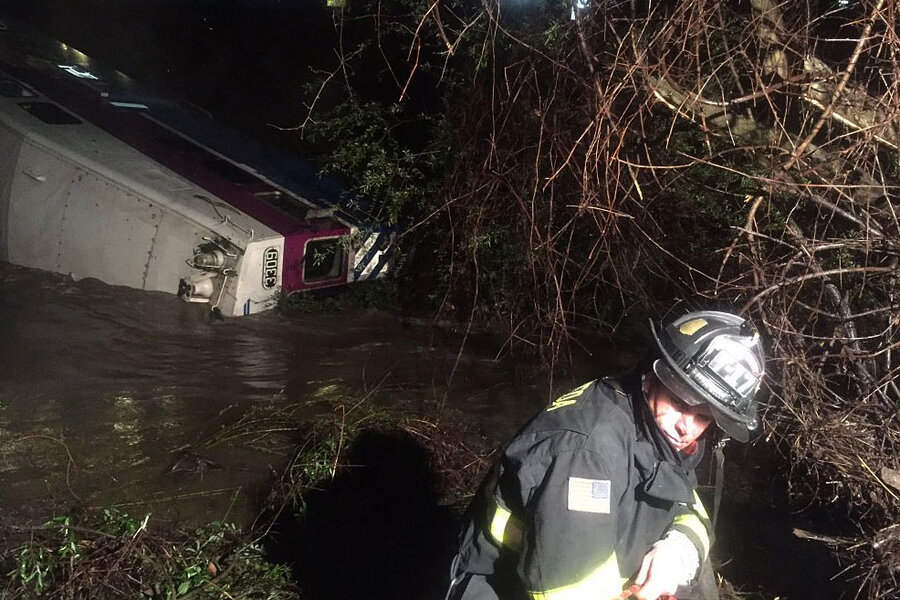California commuter train derails: How to make trains safer
Loading...
Nine people were injured Monday night when a passenger train derailed near San Jose, Calif.
An Altamont Corridor Express (ACE) commuter train left its tracks Monday after hitting a fallen tree. First responders worked through the night to rescue the 214 passengers and bus the uninjured away from the rural Niles Canyon area. Four of the nine people injured were taken to the hospital with non-life-threatening injuries, according to an ACE media release.
"It was dark, wet, it was raining. It was very chaotic," Alameda County Sheriff's Sgt. Ray Kelly told the San Francisco Chronicle. "This is an absolute miracle that no one was killed, no passengers or first responders."
Passengers said they believe the first two cars derailed when the train hit a tree that had fallen during a mud slide caused by heavy rain, according to San Jose TV station KNTV. The first derailed car of the ACE No. 10 tipped into Alameda Creek, and the train's riders, crew, and, eventually, first responders pulled the passengers from the creek, which was swollen with rain.
"It just shifted the gravity all of a sudden and we were all just panicking," a passenger in the front car, told KNTV while he waited for a ride home. "There were two people hurt, pretty badly. One was just under the mudslide so we were trying to dig her out while the train was hanging so it was a pretty crazy experience."
Altamont Corridor Express sent buses to take passengers who were unhurt to the Alameda County Fairgrounds and has stopped trains scheduled for Tuesday. The sheriff told KNTV that workers would need daylight to fully assess and repair damage to the tracks, and the Federal Railroad Administration was on the scene Tuesday, spokesman Michael Cole said in a statement.
The state of California has spent the last decade trying to improve train safety following a particularly bad accident in 2005, and the state was the first to implement Positive Train Control (PTC), a GPS system designed to prevent rail accidents, The Christian Science Monitor wrote:
The state of California attempted to address rail safety directly following two deadly accidents in southern California. In 2005, 11 people were killed and 180 others injured after a commuter train crashed into an SUV on the track, causing the train to derail and collide with a freight train in Glendale. Then, three years later, a Metrolink train collided head on with a freight train, killing 25 people and injuring 135.
In the wake of the 2005 crash, the Southern California Regional Rail Authority launched a myriad of projects designed to improve grade crossings, to build safer cars and locomotives, and to use automatic train stops and onboard rail video cameras.
Safety measures are still being implemented, but still cannot always prevent, or even predict, accidents such as Monday's. Obstructions on railroad tracks were the nation's second-most common cause of train accidents, accounting for almost 10 percent since 2012, according to Department of Transportation statistics. California also has the third-highest number of accidents compared to other US states, although its record has been improving since 2013.
Congress has also passed a bill to help the Department of Transportation update safety technology for railroads nationwide, but as of the December 2015 deadline for installing PTC, the department told Congress only 29 percent of commuter rails had successfully done so, according to The Christian Science Monitor. The department estimated that full installation would not be possible until 2020.








